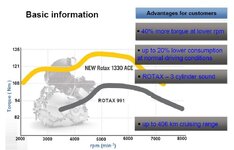You cannot damage anything by "lugging" the engine, except by opinion, since the automatic downshift timing is engineered to prevent that. In fact, that's the sole purpose of that downshift, I think. Same with the upshift: the paddle only "requests" the shift... Nanny then performs it only when RPM is sufficiently high.
But, hey, I've been known to be wrong before!
I doubt very much that you are wrong on either of those facts missouriboy! :thumbup:
More than one BRP Trained Spyder Tech/Engineer/Guru here in Oz has said exactly that & others very much the same thing when directly questioned about those 'auto' downshifts - they are all pretty unanimous that the auto-downshift's
major purpose is to protect the engine from lugging & clutch/transmission from running too high a torque load & the consequent damage that may occur whenever road speed drops below that viable for the given revs/gear/road speed; with the '
auto-downshift' feature promoted by the marketing & sales team simply tagged on as an after-thought! :sour: And as you suggested, they
all also said the same goes for shifting
up too early - no matter how often you flap the flappy paddle, if you don't have suitable revs/road speed for the next higher gear to pull that gear safely, then the computers just don't let the up-shift happen until you do!

So Kasper, you can up-shift from whenever/whatever revs the computers will let you right out to the red line without issue, cos the computers won't let you up-shift too low & the rev limiter feature of the engine's computer control unit will cut you off if you rev it out too far past that red line!

As for that ECO thing, it certainly works to
help you learn the lowest viable up-shift revs for a given revs/gear/road speed combination & might even give you the misapprehension that you're actually saving more than just a dribble of fuel, but do be aware that when you select ECO Mode, it not only turns on that Green Arrow, but it also downgrades the 'fly-by-wire' throttle input by a fairly significant amount!

So if you do choose to use ECO Mode, you'll really be
further restricting the engine's potential power output and the Spyder's performance capability from the already '
de-tuned for Spyders' levels that we get from the factory (just to make sure you don't have too much fun!

) because in ECO Mode, you'll
NEVER achieve Wide Open Throttle or Full Revs in any gear, not even for the moment that the 'normal' factory tune allows! :banghead:
Just Sayin' :cheers:



